The sys admin's daily grind: Shell In A Box
Sea Shells in a Box
At some point, any service that can't run fast enough will be put on the web. So, why not do this for remote login? With a little JavaScript and CSS wizardry, a software tool called "Shell In A Box" sends a shell to the browser.
The web login tool I am looking at today is available in many distributions, or you can download it from the website [1]. I got Shell In A Box to jump onto my Kubuntu lab machine like this:
apt-get -fym install shellinabox
It runs as a service in the background, normally listening on port 4200. When I then surf to localhost:4200, I see the Bash login prompt and can log on and go about my work in the normal way (Figure 1). It doesn't even have to be a full login. I can also redirect the output from programs running in Bash to the web.

Shell In A Box is easily configurable. Typing
shellinaboxd -t--localhost-only -p 8001--no-beep -s'/htop/:nobody:nogroup:/:htop-d 5'
beams the Htop process monitor into the web. The -t parameter disables SSL encryption, which is enabled by default. Switching this off here is less critical than you might think, because I am only letting Shell In A Box listen locally on 127.0.0.1 – in a box in the true sense of the word. If you don't like the idea of the default port (4200), you can choose a different one; this is handled by -p 8001 in my example. The --no-beep option disables the annoying notification tones.
Miscellaneous Crustaceans
The -s parameter is followed by the actual shell command, whose output you want to display in the browser. You can do this with multiple box shell instances at the same time, which is why I specified a URL (/htop) to distinguish between the instances. To see the output, I thus need to enter a URL of http://127.0.0.1/htop in my browser's address bar. The results look like Figure 2.

Besides statically displaying the typical text flow from standard command-line tools, the browser also supports interactive working, assuming that the tools you use have an interactive mode. For example, if you press the M key in the Htop output, the browser shows the processes sorted in descending order by memory requirement, just as in the native command line.
As always in production operations, I would advise caution with the shellinaboxd. If you export your Bash to the web, you should at least insist on HTTPS. The user rights also need to be as conservative as possible, as shown in the Htop example, where I specified nobody:nogroup.
Charly Kühnast
Charly Kühnast is a Unix operating system administrator at the Data Center in Moers, Germany. His tasks include firewall and DMZ security and availability. He divides his leisure time into hot, wet, and eastern sectors, where he enjoys cooking, freshwater aquariums, and learning Japanese, respectively.
Infos
- Shell In A Box: https://code.google.com/p/shellinabox/
Buy this article as PDF
(incl. VAT)
Buy Linux Magazine
Subscribe to our Linux Newsletters
Find Linux and Open Source Jobs
Subscribe to our ADMIN Newsletters
Support Our Work
Linux Magazine content is made possible with support from readers like you. Please consider contributing when you’ve found an article to be beneficial.

News
-
Canonical Releases Ubuntu 24.04
After a brief pause because of the XZ vulnerability, Ubuntu 24.04 is now available for install.
-
Linux Servers Targeted by Akira Ransomware
A group of bad actors who have already extorted $42 million have their sights set on the Linux platform.
-
TUXEDO Computers Unveils Linux Laptop Featuring AMD Ryzen CPU
This latest release is the first laptop to include the new CPU from Ryzen and Linux preinstalled.
-
XZ Gets the All-Clear
The back door xz vulnerability has been officially reverted for Fedora 40 and versions 38 and 39 were never affected.
-
Canonical Collaborates with Qualcomm on New Venture
This new joint effort is geared toward bringing Ubuntu and Ubuntu Core to Qualcomm-powered devices.
-
Kodi 21.0 Open-Source Entertainment Hub Released
After a year of development, the award-winning Kodi cross-platform, media center software is now available with many new additions and improvements.
-
Linux Usage Increases in Two Key Areas
If market share is your thing, you'll be happy to know that Linux is on the rise in two areas that, if they keep climbing, could have serious meaning for Linux's future.
-
Vulnerability Discovered in xz Libraries
An urgent alert for Fedora 40 has been posted and users should pay attention.
-
Canonical Bumps LTS Support to 12 years
If you're worried that your Ubuntu LTS release won't be supported long enough to last, Canonical has a surprise for you in the form of 12 years of security coverage.
-
Fedora 40 Beta Released Soon
With the official release of Fedora 40 coming in April, it's almost time to download the beta and see what's new.

